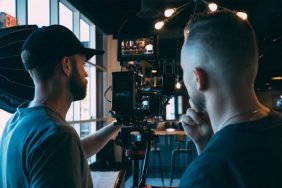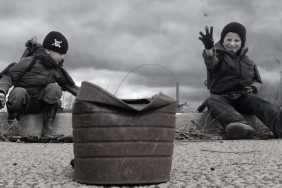I offer no disclaimer. This week’s Free Film School may seem dry to the layman, but I, Witney Seibold, your strikingly intelligent (not to mention devilishly handsome) professor will be making a somewhat rudimentary piece of camera equipment seem as dynamic and important to your filmgoing experience as it has been to the filmmaking world at large. It’s my job to make you see film in a new light, and get you thinking about small details of film you may not have otherwise given any thought to. You may currently be lost when I mention the word “Steadicam,” but, my lovelies, you will see how dramatically it revolutionized film.
Here we go:
So, Danny Torrence (Danny Lloyd) is riding his Big Wheel tricycle through the seemingly endless hallways of the Overlook Hotel. He is alone. He rides through the main hall of the hotel, and we hear the plastic wheels of his toy echo from the walls. He rides over small area rugs, through a large ballroom, down a hallway, around a corner, and is stopped dead by the sight of two twin girls, standing stock still about thirty feet ahead of him. This is one of the most famous shots in all horror cinema. It is from Stanley Kubrick’s 1980 classic The Shining. How in hell did Stanley manage to get that shot? The camera follows the Big Wheel at a very low angle, almost touching the floor, and it continues, unedited and unbroken, for minutes. The camera is clearly not on a track, and it moves too quickly and too smoothly to be on wheels. Cameras in 1980s, mind you, still shot exclusively on film, and were massive, heavy objects. Well, thanks to a breakthrough in camera technology in 1976, Kubrick had access to a special balancing device that pretty much revolutionized the way we shoot movies.

These days, thanks to some of the wilder camera angles available only through digitally animated film, getting the correct shot is less a technical matter, and is more often bound only by the filmmaker’s imagination and capacity for aesthetic restraint. But, when one is using a camera, and you want the camera to move, it’s likely that you’ll be using one of the most ubiquitous pieces of camera equipment in the business: The Steadicam. Some lightweight digital cameras (that don’t require large rolls of film to weight them down) may be far more portable than their heavier forebears, so toting them about may not be so difficult. But, no matter what kind of camera you’re using, in order to give your tracking shot a lightweight, non-shaky appearance, you’ll most definitely need to strap a Steadicam rig onto your cameraman. Steadicam shots are so common in films, it’s likely that you barely even register them anymore. But thanks to this backpack-looking rig, movies have evolved more dramatically than one could previously imagine.

A Steadicam is essentially a miniature weighted crane arm that often straps bodily to the cameraman’s chest. It is weighted down on the bottom with an extended anchor (usually containing a battery or some extra film canisters), and a series of springs and plungers within the crane arm keep the camera as shake-free as possible, even if the cameraman is walking heavily. It essentially erases all shake and footstep from a handheld camera shot. Some Steadicams are even more rudimentary, having a series of low-hanging stabilizing weights, and no chest rig. If you ever see a camera rotating 360° around a character, it was likely done with a Steadicam. If you see a slightly shaky, energetic tracking shot that quickly changes angles without an edit, it was done with a Steadicam. Indeed, it’s likely that, in many films, if the camera is moving at all, the majority of the time it will have been achieved with a Steadicam.
The Steadicam was invented in 1976, and is currently a registered trademark of a company named Tiffen, but, like Kleenex and Band-Aid before it, it has kind of become a default phrase for anything that resembles that particular product. Before the Steadicam, filmmakers could only achieve tracking shots (that is to say: any shot where the camera moves, without merely swiveling on a tripod’s pivot point) by either walking with an enormously heavy camera on the shoulder of a cameraman, or building a special track (like a train track) for the camera to run on. Occasionally, in higher-end productions, the camera could even be mounted on a smooth-moving crane, allowing the camera to float high in the air. One of the most famous crane shots in film history has to be the shot of the hundreds of wounded soldiers about halfway through 1939’s Gone with the Wind. Pre-Steadicam, tracking shots were essentially side-to-side affairs. For a modern-day parallel, think of the original 1985 Super Mario Bros. video game, and compare it to 1996’s Super Mario 64. The original was a side-scroller, and could only pan from left to right. As if a camera on a straight track was filming him. Super Mario 64 could finally show Mario from several angles, and perspective could “zoom” through a rendered scenario. As if a cameraman was running around him, and following him.

The Steadicam allowed filmmakers to finally move the camera almost however they liked. If someone could walk there, a camera could be placed there. If someone was walking down a street, the camera could follow them from behind, the front, or any angle in between. It allowed Kubrick to follow little Danny as I indicated above. It allowed Martin Scorsese to achieve that stellar unedited shot in GoodFellas (which I have mentioned in the Free Film School before, in the lesson on shot length) wherein the characters enter a nightclub through the kitchen. Indeed, Steadicam shots quickly proliferated through filmmaking, and it’s hard to think of a major film made since 1980 that doesn’t have several Steadicam shots in it. I have learned from some cursory internet research that the famous bike chase in Return of the Jedi (1983) was achieved using a few different Steadicam shots, sped up, and with the characters superimposed over them.
Consider how freeing this must have felt to filmmakers in the late 1970s and early 1980s. A new level of immediacy and spontaneity was suddenly added to the filmmaking toolbox. Rather than having to meticulously set up elaborate tracking shots, or leave a static camera in one place at all times, making for long lighting setups and equipment movement, directors and cameramen could easily follow the action great distances. In theory, a single shot could last for as long as a film reel now, and be moving the entire time. Cameras could be brought onto boats, in cars, over bridges, up and down city streets, all with a newfound smoothness of movement. The Steadicam shot is still, to this day, not infallible, and some natural shifting of the frame will occur, but that typically only adds to the quickness and hotness of a scene. (I use “hotness” in the McLuhan sense; I officially give you permission to punch me for bringing up Marshall McLuhan when you next see me.) This new movement of the camera made films less theatrical, and more dynamic. Whether you’re running alongside Tom Cruise in The Firm, or slowly following dejected teens down a hallway in Elephant, the Steadicam made it possible.
Indeed, the Steadicam was so conducive to the use of small (read: inexpensive) lightweight cameras, that many TV shows today are shot almost exclusively using them. Think of the average episode of Law & Order. How many shots are of cops walking down sidewalks, or lawyers walking down hallways? I’m willing to bet it’s about 75% of the shots in any given episode.
A lot of filmmakers have used digital effects to decrease (or in some cases, increase) the “shakiness” of an image, but make no mistake; editors and digital mechanics have not been starting from a tremor-filled handheld consumer-grade camcorder image. They are typically working with a Steadicam shot. Some filmmakers use the ease of movement as an opportunity to show off how long they can extend a shot. Consider a particular shot in Raising Cain, a 1992 film directed by Brian DePalma. In the film, a psychology expert gives a brief rundown on the phenomenon of multiple personalities to a pair of mildly interested cops. The conversation is held as the three of them walk through crowded hallways, down several flights of stairs, and even into an elevator. There are no edits for nearly four minutes. The lack of editing doesn’t, in this case, necessarily add to the dramatic tension of the scene (DePalma does seem to be merely flexing his muscles), but it is impressive, and could only have been achieved with a Steadicam. I think the length of the scene was, perhaps, only included to stress the shocking reveal of a dead body at the end of it.
Compare that scene to the famous unbroken shot in the pre-Steadicam 1964 film I Am Cuba, directed by Mikhail Kalatozov. To this day, there seems to be some scholarly debate as to how a shot like this was achieved. While the scope and movement of the camera is broad and impressive, you’ll notice it still has a handheld quality. A shot like this, without using a Steadicam, seems near impossible, and was likely achieved using weeks and weeks of careful planning and rehearsal. There was a time when spontaneity had to be carefully rehearsed. This shot really is one of the more impressive in all cinema. Watch it.
Steadicams now come in countless subtle varieties, and, should you be one of those tech-obsessed film-loving gearheads (and I know there are at least a few of you out there) you can read all about them on their website. Once you become a Steadicam operator, you can even join their union.
The next time you see a film, try to pay attention to how much the camera moves. Does it move slowly or quickly? Is there any natural hand movement, or does it glide silently? Either way, you’re probably looking at the movie through the balanced eye of this amazing piece of equipment.
HOMEWRK FOR THE WEEK: Try shooting a tracking shot yourself on a home camera, or on a telephone camera. Try walking from your living room to your bedroom. How steady can you hold your camera? Now imagine if the camera was one hundred times the weight. How would you balance the shot? How does the free movement of the camera change the drama of a film? What kind of shots should be tracking shots, and what kind should be static? Which is more appropriate?
If you have a topic you’d like Professor Seibold to cover in a future edition of Free Film School, let us know!






